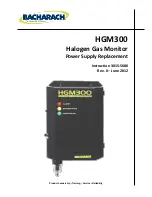54 • Troubleshooting
Troubleshooting
The troubleshooting guide describes symptoms, probable causes, and
recommended action for problems you may encounter with the Beacon
200.
NOTE: This troubleshooting guide describes controller problems only.
See the detector head instruction manual(s) for troubleshooting
procedures that apply to the detector head(s) supplied with your
Beacon 200.
Table 11: Troubleshooting the Beacon 200
Condition
Symptom(s)
Probable Causes
Recommended Action
No Power
•
The PILOT light is
off.
•
The display screens
are blank.
•
The power wiring is
disconnected or
misconnected.
•
One or both AC fuses
or the DC fuse is
blown.
•
The display cable is
disconnected or
misconnected.
1. Verify that the wiring to the power
source is correct and secure.
2. At the Beacon 200, verify that the
wiring to the AC terminals is correct
and secure.
3. Check the continuity of the applicable
(AC or DC) fuse.
4. Verify that the display cable is
connected.
The display (ribbon) cable plugs into
connectors on the top edge of the
display board (labeled J1) and on the
top edge of the main circuit board
(also labelled J1).
5. If the power difficulties continue,
contact RKI for further instruction.
Frequent or
Suspect
Alarms
•
The Beacon 200
alerts you to
frequent or suspect
alarms.
•
The detector head’s
fresh air readings
remain on zero
(20.9 for oxygen).
•
The Beacon 200 is
experiencing false
readings due to RFI or
EMI.
•
The detector head
wiring is
disconnected,
misconnected, or
intermittent.
1. Verify that the detector head wiring is
properly shielded (see the detector
head instruction manual).
2. Verify that the detector head wiring is
correct and secure.
3. Verify that power and detector head
wiring is routed through separate
conduit hubs on the bottom of the
Beacon 200 housing.
4. Increase the alarm on delay setting in
the Channel Control & Setup
Program.
5. If the frequent or suspect alarm
difficulties continue, contact RKI for
further instruction.


















